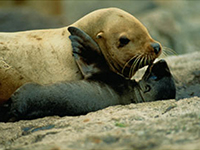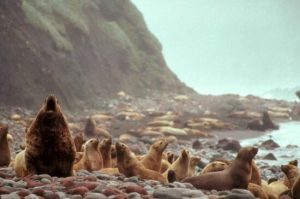Discovery and the Scientific Method (Week 2 of 2) – Make Up Module

- Upload your Library Tutorial Assignment to Moodle.
- Read Activity 1 Background (Appendix E, review pages 221-222 and read about graphs, pp. 222-225)
- Upload the Initial Experimental Design Assignment to Moodle (see Lab 2 – week 1 for the EPD assignment description).
Review of Pill & Sow Bug graphs and Experiments – if not done the previous week – Make Up Module
- Meet with your TA in office hours or via Zoom – Present and discuss your experiment (completed page 21 and set up notes) and graph with your TA. In reflecting on your experiment and results, what ideas would you have for revisions? What challenges did you face designing an experiment (besides not doing it in person!).
Activity One: Data Analysis – A Case Study of the Factors Contributing to the Decline of Steller Sea Lions (p. 16-17) Make Up Module
 |
 |
- Steller Sea Lion Research – Interpreting Graphs and Tables (p. 16)
- Read the Background on page 16.
- Your TA will assign you ONE of the Figures (data table or graph) to interpret in the link below.
- Steller sea lion graphs and tables.
- Answer questions 1 a, b, c, d in your lab manual for your assigned figure. Appendix E in your lab manual (or in the Resources webpage) pages 221-224 may be helpful.
- Then you should choose 2 other figures and explain what each of them convey.
- Write a discussion on how these THREE figures relate to one another and provide insight into the decline of Steller Sea Lions.
- Scan or take a picture or type up all of your completed work for Activity One, p. 16-17, and email to your TA.
Initial Experimental Design Peer Review – Discuss with your TA how to make up.
- Initial Peer-Review form to use in class for the Initial Experimental Designs – Peer Review Criteria. Each student will share their Initial Experimental Design in a group google folder and ALSO verbally present their Initial Design to their group. Then provide time afterwards for discussion.
- Each of your peers will fill out this Peer-review form for your proposed experiment before moving along to the next student in the group. The Peer-review form is used to evaluate the design of each group member.
- Email a copy of each form you fill out to the appropriate presenter. Comments should be constructive (what is good, what needs work, what is unclear), are the variables appropriately designated? This way each group member will get a Peer-review form from EACH person in their group. That is a lot of helpful information!
- In addition to providing Peer-reviews for each other, you should copy and paste all the peer reviews you wrote and upload these into in Moodle for the Lab 2.2 In-Lab: Peer Review Experimental Design.
- You will also need to copy and paste ALL the Peer-reviews you receive to include them all at the end of the Final Experimental Designs that you will submit in Moodle 48 hours after lab. This way you keep all your feedback with your design plan.
Sample Scientific Papers
Sample Scientific Papers – Primary vs. Secondary literature, pp. 17-18 – activity/discussion – review 5 Sample Scientific Papers as a class:
- Is your paper Primary and Secondary literature? How can you tell?
- How well did the paper follow Lab Report/Scientific literature structure? Did anything seem odd or different for you? Does this change your idea of Primary or Secondary Literature? Why or why not?
Oral Scientific Communications: Presentations – Use for your Experimental Design Final Presentation

- Appendix C: Making Presentations in your lab manual
- Organize information and PRACTICE before you present.
- Be professional in what you present (use visuals) AND in what you say.
- Your presentations should follow the same general format/sections of a scientific paper.
- Include primary literature references in your presentation.
- Be prepared to answer scientific questions related to your experimental design, results, etc.